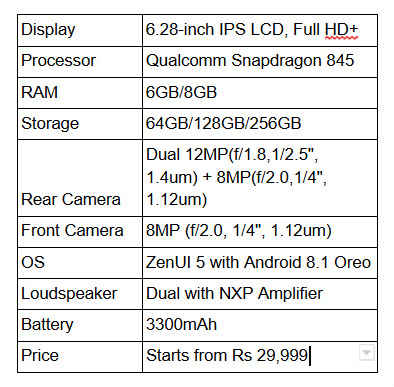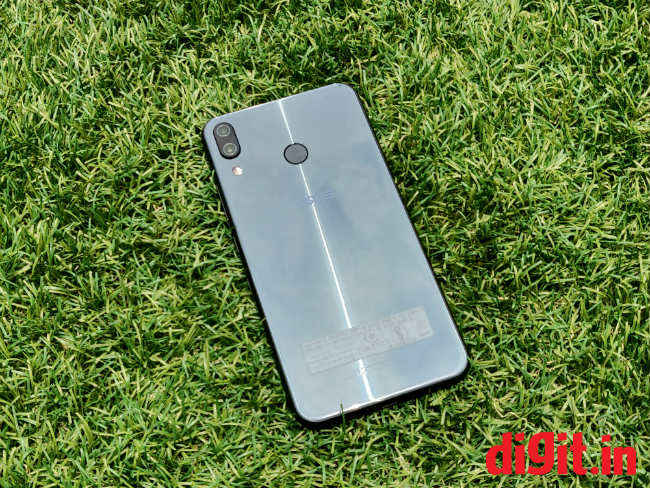Asus Zenfone 5z First Impressions: Can it beat the OnePlus 6 at its own game?

The Zenfone 5z seems to offer excellent value for money, even more than the OnePlus 6 which has carved a name for itself in offering flagship features at not-so-flagship prices.
Asus’ Zenfones have always been in the game, but were never really considered serious contenders in challenging the superiority of flagships. It’s not like Asus hasn’t tried. Once upon a time, the Taiwanese company thought it would be wise to launch a flagship phone worth Rs 60,000 in a price sensitive market like India. Naturally, that didn’t go down well with the loyalists and thankfully, Asus learned from it. Had the Asus Zenfone 5z commanded a similarly steep price, it might just have followed HTC’s footsteps.
Hardware Specs:
Now, while Asus has toned down on its ambition of charging a kidney, it hasn’t shied away from innovating in the technology itself. The Zenfone 5z packs everything a flagship does, sometimes even more than the flagship killer, the OnePlus 6, and commands a visibly lesser price for it. How Asus managed to bring down the price, that’s something I’ll be curious about. Nevertheless, the Zenfone 5z is here and the high-end segment is now the most exciting segment after the mid-rangers.
There aren’t many Snapdragon 845 powered phone in India this year, so when a flagship-processor touting smartphone launches, everyone sits up and takes note. The Zenfone 5z offers that flagship performance for under Rs 30,000. It’s perfectly responsive, fast and seems reliable for the few days I used it. Granted it isn’t as fast as the OnePlus 6 (review), but that isn’t taking anything away from the experience. Instead, Asus offers more than just sheer speed in the Zenfone 5z. It offers a compact design that feels almost as ergonomic as the Samsung Galaxy S9 (review) The notched display is a concern and I’ll forever wonder the reason behind going for that ugly cutout. In the iPhone X’s (review)defense, it needed to pack a Microsoft Kinect-like camera on top of the panel and offer an edge-to-edge panel. The Zenfone 5z offers neither. There isn’t a dot projecting 3D camera for facial unlock (it uses the front camera like most other Android phones), neither is it truly bezel-less. There is a thick lower lip and distinct borders around the edges. It’s still the most immersive display we have seen on a Zenfone and the 6.2-inch IPS LCD panel is one of the brightest we have seen on a smartphone. It covers 95-percent of the DCI-P3 colour gamut and content on the screen looks great. The notch is programmed to not come in the way when you’re watching a video, but it’s right there when you’re reading or taking photo, in which case, the notch blocks a part of the frame.
The Zenfone 5z is also proof that glass is in. Metal unibody designs are on the way out. Asus came out with the concentric circle-like reflective unibody designs in its earlier flagships which looked glamourous, to say the least. Now it does the same with a glass body. No points for guessing where it’s drawing its inspiration from. The vertically aligned dual cameras in the top right corner is the biggest hint.
Asus’ flagship is also smarter than your average smartphone. Now, Asus would like to call that extra smartness “artificial intelligence”. It sounds cool but I’ll refrain from calling it so. The so-called AI features the Zenfone 5z is touting are simply a generous application of sensor data and machine learning. AI ringtone, AI battery, Optiflex for speeding up app launches and what not. None of these are AI in its truest sense which calls for a separate explainer into what is actually happening inside. For now, it’s safe to say that the AI engine on the Snapdragon 845 is being used by the Zenfone 5z to offer all kinds of magical capabilities that are useful no doubt, but aren’t AI by a long mile.
The ZenUI interface on the Zenfone 5z runs on the latest Android Oreo build and Asus has promised 18 months of regular updates including monthly security patches. The UI elements like icons and menu bars have mostly remained the same, but Asus has cleaned up the interface a lot by removing most of the bloatware apps. You still get a handful though, but they can be uninstalled.
But don’t let my disdain of lazy marketing come in the way of judging the phone for what it is – A great alternative to the OnePlus 6. It’s camera is also quite impressive and tries to be a little different from the usual dual-camera toting crowd. The standard 12-megapixel sensor is combined with an 8-megapixel wide-angle sensor, something that LG is known for in its flagships. It works quite all right but a definite verdict demands longer testing, so I’ll reserve that for the review.
Overall, the Zenfone 5z seems to offer excellent value for money, even more than the OnePlus 6 which has carved a name for itself in offering flagship features at not-so-flagship prices. Can the Zenfone 5z beat the OnePlus 6 at its own game? We’ll soon find out in our review.






